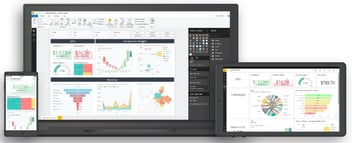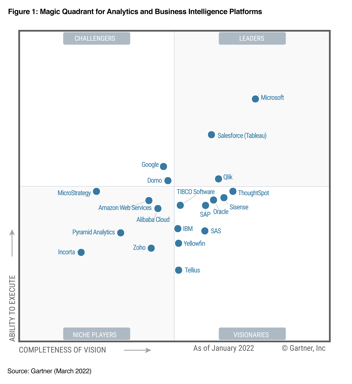Learn about Microsoft's latest data analysis updates beyond Power BI, aimed at helping businesses in the aftermath of Covid-19.
In recent months Microsoft has released several updates to its data analysis tools in response to the business transformation brought about by Covid-19. We present the most important updates.

Less than 4 months ago this blog announced the latest Microsoft updates for 2021. As a Power BI partner company and Microsoft Gold Partner in Spain, at Bismart we try to be up to date and inform you of all the latest news in Microsoft data analysis.
Technology is advancing at a rapid pace and it is often difficult for companies to keep up. Bismart offers data analysis solutions that are customised, easy to implement and geared towards achieving better business results. We have worked with companies across multiple sectors and tailor our solutions to the needs of each client.
Would you like to transform your business through data analysis and technology? Consult our solutions or ask us any questions you may have.
The US company does not rest and since our last article Microsoft has further expanded its solutions range of possibilities to meet the new data analysis needs brought about by Covid-19.
At Microsoft Ignite 2021, held on 2-4 March, the company unveiled the results of its efforts to adapt to the needs of the business sector in real time, announcing multiple updates, enhancements and even new solutions.
The timing of the announcement was no coincidence. The last 12 months have been dominated by Covid-19, which has raised new concerns and demands in both the business and technology industries. The debate on user privacy —which led Google to announce the end of third-party cookies in Google Chrome—, the economic consequences, the incipient data analysis functionalities and the new digitalisation imperatives imposed by teleworking are some of the most significant issues raised by Covid-19. On this occasion, the updates go beyond Power BI and focus on Azure, Power Platform and Microsoft Teams.
In this regard, Microsoft's CEO, Satya Nadella, used Ignite 2021 to mention what she believes are the 5 components that will drive the next generation of innovation in the cloud environment:
- Ubiquitous and decentralised computing
- Sovereign data and ambient intelligence
- Creators empowerment
- Expanding economic opportunities for the global workforce
- Trust in design
These 5 elements are the focus of Microsoft's latest innovations which, at a frenetic pace, seek to adapt to the new business and technological ecosystem and offer answers to the most urgent demands of its partners and customers.
Microsoft's latest updates in data analysis beyond Power BI
1. Microsoft Mesh: Augmented reality accessible to businesses
Microsoft has launched Microsoft Mesh, a solution that aims to take telematic meetings —which experts say will not disappear any time soon— to new horizons through augmented reality and artificial intelligence.
Microsoft Mesh will make it possible for people in different locations to share the same room using 3D avatars. The idea is that, instead of seeing someone through a screen, we will have the 3D representation of the person physically in the room. Not only that, meeting members will also be able to interact with 3D objects, exchange documents and work together.
Microsoft's approach to augmented reality does not end with Mesh or the augmented reality glasses Hololens 2, but the multinational intends to provide businesses with an entire network of augmented reality possibilities through the Azure cloud and its cloud services. The company also intends to eventually integrate Mesh with other collaborative work applications such as Microsoft Teams, Dynamics 365 or even PowerPoint and Excel.
Microsoft explained at Ignite 2021 that Mesh will bring teleworking closer to the sense of presence we have when we are in the office, which will help workers be more productive.
2. Webinars on Microsoft Teams
In line with its determination to optimise teleworking, Microsoft is extending Microsoft Teams' capabilities, which will now be able to offer interactive webinars for up to 1,000 attendees from inside or outside the organisation. If the event has more than 1,000 attendees, Microsoft says Teams will escalate the broadcast capabilities to 10,000 people, although they will only be able to view the webinar without interacting.
Seminars will include features such as speaker control over turning off video and attendee chat, enriched presentation options and post-seminar reporting, among others.
3. New synergies between Teams and Dynamics 365
Microsoft is broadening the integration capabilities of Microsoft Teams and Microsoft Dynamics 365 with the intention of improving the possibilities for collaboration in business processes.
From now on, users will be able to chat, hold meetings and make calls from Dynamics 365, without having to close the application and open Teams. It will also be possible to share Dynamics 365 content directly from Teams.
On the other hand, the integration between Dynamics 365 Marketing and Microsoft Teams is also improved, enabling now the promotion and dissemination of Teams events from Dynamics 365 Marketing, which will store data from event attendees to obtain insights. Microsoft's intention is to enable companies to create more personalised customer experiences.
4. Microsoft PowerPoint Live available in Teams
Microsoft is enriching Teams presentations through Microsoft PowerPoint Live. Meeting chat, viewers and notes will now be visible alongside the PowerPoint slides. In addition, the meeting host will be able to change the way others view the presentation, and viewers will be able to navigate through the presentation at their own pace and view whatever slides they want.
Finally, presentations will have a new feature, Dynamic View, which will automatically adjust the view of meetings when new attendees join and when a presentation starts.
5. Power Platform Upgrades: Towards the democratisation of programming
Microsoft created Power Platform —which includes Power BI, PowerApps and Power Automate— with the intention of democratising data analysis and providing companies with an environment through which to automate business processes and easily create applications without the need for developers.
With this philosophy in mind, the multinational has optimised Power Platform's functionalities to make it even more user-friendly. The main updates are:
- Power Automate Desktop becomes available free of charge to all Windows 10 users. Power Automate expands its capabilities with Process Advisor, a 'process mining' tool that will allow non-programmer users to identify processes that slow down workflows and automate them.
- Power BI Premium will also become generally available in the near future.
- Microsoft Power Fx is the open source programming language used by PowerApps and based on Excel that, according to the multinational, will make it possible for any user to communicate their logic despite not having coding skills.
- GPT-3: In addition, Power Fx will be integrated with an auto-regressive language model developed by OpenAI: Generative Pre-Trained Transformer 3 (GPT-3). This language model uses deep learning to write text in a human-like manner. Through this integration, users will be able to create applications easily as they will not have to write code.
6. Azure Percept: Democratising artificial intelligence
Finally, Microsoft has launched a new artificial intelligence platform: Azure Percept, which includes Azure Percept Vision and Azure Percept Audio. The tool is integrated with Azure Machine Learning, Azure Cognitive Services and Azure Live Video, among other Azure tools.
With this offer, Microsoft aims to enable organisations to benefit from perimeter intelligence without having to hire engineers or data scientists.
Microsoft's updates come at a time of transformation in both the business sector and in data analysis, which is increasingly oriented towards artificial intelligence, the democratisation of data and cloud services. Through these new functionalities, Microsoft aims to bring companies closer to the new trends in the sector and facilitate their adaptation to the new reality driven by Covid-19.
Data is already the basis of most business processes and companies are moving at a frenetic pace towards leveraging technology and data analysis. Tools such as Power BI, Azure Pureview or Azure Synapse are gradually becoming essential for the smooth running of companies.
Do you want to transform your business through data and technology? We can help you! Bismart has been driving the digital transformation of businesses in different sectors for years and we offer free advice. Have a doubt? Talk to one of our experts!



